Have you ever wondered what those numbers on your binoculars mean? Well, I’m here to demystify that for you.
Binocular specifications, often found etched into the casing or included in the product description, can seem like a secret code if you’re unfamiliar. But don’t worry – they’re pretty straightforward once you understand what they represent.
The first number is the magnification power. It’s how much closer an object will appear than viewing it with the naked eye. So, if your binoculars are labeled “10×50, ” whatever you’re looking at will appear 10 times closer than normal.
The second number is about the size of the objective lens (that’s the lens at the front of your binoculars).
In our “10×50” example, 50 is a 50mm objective lens diameter. This measurement affects how much light enters your binoculars – bigger lenses let in more light and generally provide brighter and clearer images.
Don’t be fooled into thinking bigger is always better, though! Bigger lenses mean heavier binoculars and sometimes less clarity around the edges of your view. It’s all about finding a balance that works for your specific needs.
Understanding the Numbers on Binoculars
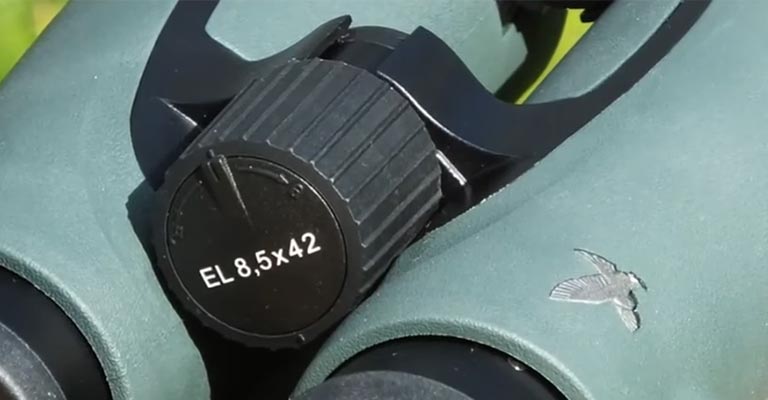
Ever wonder what those numbers stamped onto your binoculars are all about? Well, I’m here to shed some light. You’ll often see a configuration like “8×42” or “10×50”; these aren’t just random digits. They hold key information about the capabilities of your binoculars.
The first number in this sequence, an 8 in an “8×42”, refers to the magnification power. That means objects will appear eight times closer than they would to your naked eye.
It’s like getting up close and personal without actually moving a muscle! On the flip side, if you have a pair marked “10×50”, you’re dealing with ten times magnification.
On to our second number now. This one tells us about the diameter of the objective lens – that’s the big lens at the end of your binoculars if you’re unfamiliar with the term.
So, for an “8×42”, we’ve got lenses that are 42mm wide. Why does this matter, you might ask? Larger lenses allow more light into your binoculars, improving image brightness and clarity, particularly in lower-light conditions.
Here are some examples:
| Magnification | Lens Diameter (mm) |
|---------------|--------------------|
| 8 | 42 |
| 10 | 50 |
Remember, though – bigger isn’t always better for lens size! Larger lenses make for heavier binoculars, which could be a trade-off between image quality and comfort.
It’s also worth noting that these numbers can influence the field of view – how wide an area you can observe through your binoculars. Higher magnifications generally result in narrower fields of view.
So there we have it – mystery solved! The next time you pick up a pair of binoculars, you’ll know exactly what those numbers mean. Ultimately, it’s all about finding the right balance that suits your needs. Happy viewing!
Magnification Power
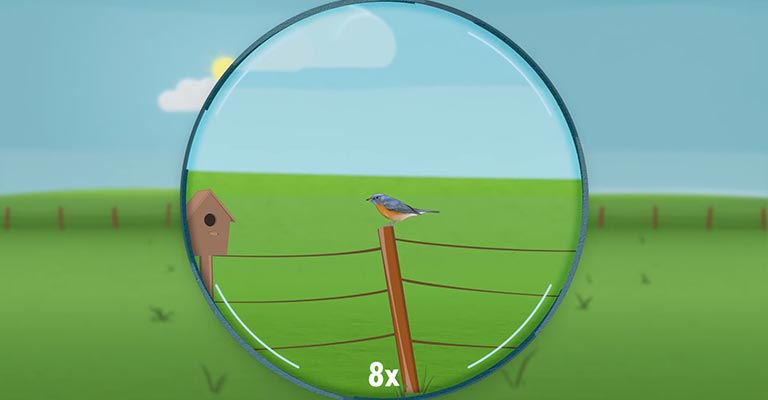
Have you ever found yourself squinting at the specification sheet of a pair of binoculars, wondering what those numbers mean?
Let’s break it down. The first number you’ll see refers to magnification power. So, if you’re looking at a pair labeled ‘8×40’, that ‘8’ is your clue about how close objects will appear when you look through these binoculars.
Magnification power is how much closer an object appears to you than it would to your naked eye. In our example, an 8x magnification means that whatever you’re observing will seem eight times closer than it is.
To put that into perspective, imagine standing a hundred yards away from a deer in the wild. With 8x bifocals, that distance would feel more like twelve and a half yards – much closer!
However, while high magnification might sound like a good thing initially – who doesn’t want superhuman sight after all – there are some trade-offs to consider, such as:
-
Greater shake: Higher magnifications can amplify handshake or wind movements, making the viewing experience less stable.
-
Reduced field of view: The higher the magnification, the narrower your viewing field becomes.
-
Less light: High-magnified binoculars generally let in less light, which might affect clarity, especially under low-light conditions.
For general purposes like bird watching or hiking, the 7x-10x range is often recommended to balance size and clarity.
Finally, remember this simple rule when shopping for your next pair of binoculars – understand what you need them for before deciding on the right level of magnification.
An astronomer stargazing may require drastically different specs than someone spotting birds in their backyard!
Objective Lens Diameter
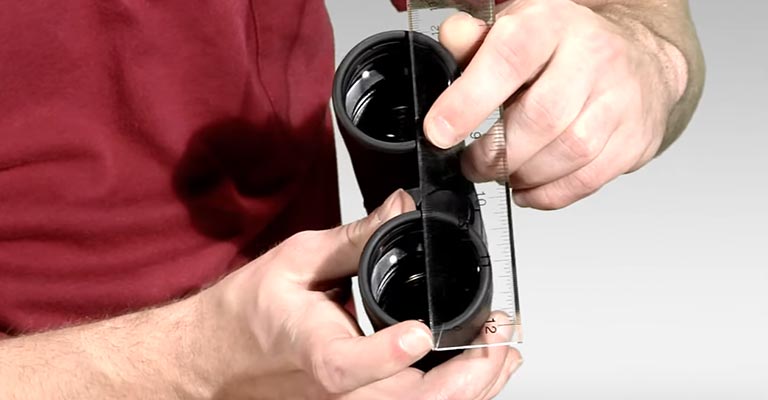
Peering into the world of binoculars, it’s easy to get lost in the numbers. One of those crucial figures you’ll often stumble upon is the objective lens diameter. So, what’s this all about? I’m glad you asked!
First, when you see a pair of binoculars described as “8×40” or “10×50”, that second number is the diameter of the objective lens – measured in millimeters. For instance, a 10×50 pair has an objective lens with a 50mm diameter.
But why should we care about this particular number? It is pivotal in determining how much light your binoculars can gather. The larger the diameter of these lenses, the more light they’ll capture. Picture it like windows: bigger windows let in more sunlight.
-
An 8×40 model will typically be brighter than an 8×25
-
A 10×50 model would generally outshine a 10×42
However, there’s more to consider than just brightness. A larger lens also translates to heavier binoculars. So you might have to decide between extra light and comfort during extended use.
Let’s look at some examples:
|
Binocular Model |
Objective Lens Diameter (mm) |
Weight |
|---|---|---|
|
Nikon Prostaff 7S 10×42 |
42 |
Light |
|
Celestron SkyMaster Giant 15×70 |
70 |
Heavy |
As shown above, while Nikon Prostaff offers less brightness due to its smaller lens size (42mm), it compensates for that with its lightweight design, which makes for comfortable prolonged usage.
In contrast, Celestron SkyMaster, boasting a large lens size (70mm), can gather more light, thus providing bright images, but is on the heavier side, which might affect its ease of use during extended periods.
So, as you can see, this number is more than just a figure. It’s a balancing act between brightness and usability.
Understanding the objective lens diameter will help you choose binoculars that best suit your needs, whether for bird watching, stargazing, or exploring landscapes!
Exit Pupil Diameter
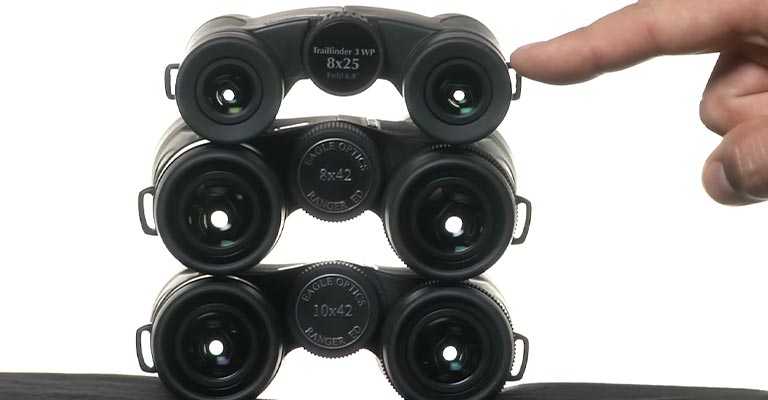
Peering into the world of binoculars, it’s important to understand what exit pupil diameter means.
Simply put, the exit pupil is the size of the column of light that leaves the eyepiece of a pair of binoculars. The larger this number, the brighter and clearer your view will be, especially in low-light conditions.
Calculating this value isn’t rocket science. You divide the second number on your binoculars (the lens diameter) by the first number (magnification). So, for a pair marked 10×50, you’d divide 50 by 10 to get an exit pupil diameter of 5mm.
Why does this matter? Well, consider this: Your pupils dilate to let more light in when it’s dark out – up to about 7mm for most people.
So, if you’re using your binos at night or in dim conditions, having an exit pupil diameter close to or greater than your dilation can make all the difference.
However, when your pupils might only dilate to around 3mm during bright daylight hours, having a large exit pupil doesn’t provide any benefit since your eyes won’t be able to use all that extra light anyway.
In these situations, you could opt for binoculars with smaller lenses (and thus smaller exit pupils), which are often lighter and easier to carry around.
In summary:
-
Large exit pupils = better for low-light viewing
-
Small-to-medium exit pupils = usually fine for daytime use
So next time you’re shopping for a new set of field glasses or bird-watching binos, don’t forget that little detail – it may help shape your decision!
Field of View
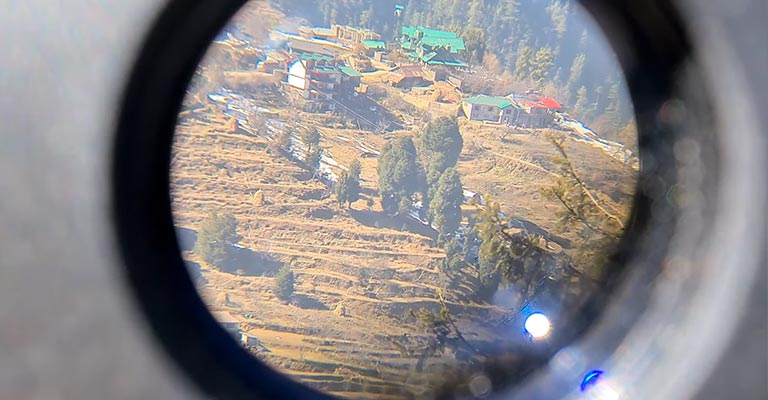
Diving into the world of binoculars, one can’t bypass the term ‘field of view’. It’s an essential piece in understanding what numbers on binoculars mean. So, let me tell you a bit more about it.
Field of view (FOV) refers to the width of the area visible through your binoculars. It’s measured in degrees or at a specified distance, say 1,000 yards.
If you’ve ever seen a number like “5.7°” or “300 feet at 1000 yards” on your binoculars, that’s the field of view talking!
You might wonder why this matters. Well, if you’re trying to follow fast-moving action – think birds in flight or athletes on a field – a wider FOV helps keep everything in sight without moving your binos around too much.
Conversely, for detailed observations like stargazing or deer spotting, where precision is key, narrower FOVs often work better.
Let’s illustrate this with some numbers:
|
Type |
FOV |
|---|---|
|
Binoculars are good for bird-watching |
8° (420 ft at 1000 yds) |
|
Standard full-size binoculars |
6-7° (315-367 ft at 1000 yds) |
|
Binoculars are ideal for astronomy |
<4° |
These are rough estimates; figures may vary based on different models and brands.
While discussing numbers associated with binoculars’ specifications, it’s worth mentioning that larger objective lenses generally offer wider fields of view.
However, they also make your pair bulkier and heavier – so there’s always a trade-off to consider!
Lastly, remember: when choosing optics equipment like binoculars – personal preferences play a big role in technical specifications!
Conclusion
I’ve spent this blog post breaking down what the numbers on binoculars mean. Now, I’m confident you’re ready to navigate the world of binocular specs like a seasoned pro.
Firstly, remember that the first number represents magnification power. That’s how much closer your subject will appear than just using your naked eye. If you see a ’10’ there, the object will seem ten times nearer than it is.
Then we have the second number – it’s all about objective lens diameter or size. The larger this figure, the more light enters your binoculars and brightens your view. So, if you’re an early bird or love stargazing, pay attention to this one!
Let’s do a quick recap:
-
First Number: Magnification Power
-
Second Number: Objective Lens Diameter
Understanding these basic concepts can enhance your binocular experience and ensure you get the most out of your chosen model.
Whether bird watching in low light conditions or scaling mountainous terrains for breathtaking views, knowing what those numbers mean can make all the difference.
And hey, next time someone asks, “What do those numbers on binoculars mean?” I bet you’ll be able to explain with confidence! Happy viewing!